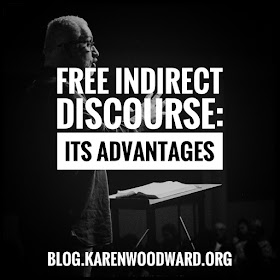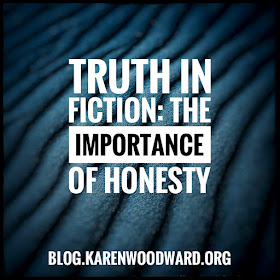When I began writing, I wrote from the first person perspective. Lately, though, I’ve been experimenting with free indirect discourse.
What's so great about free indirect discourse? I hear you ask. Well, with free indirect discourse, the narrator can float between the third person and the first person.
Because you're writing in third person, your narrator can be in any scene, but because you're using free indirect discourse your narrator can plunge into the viewpoint character’s consciousness.
If you're a bit dubious, please let me try to unpack what I just said! 😀 (BTW, if you want to read more about this topic, I've put links to a few articles on the subject at the end of this post.)
The Benefits of Free Indirect Discourse
Here are a few examples:
Direct discourse:
Alice sensed something fly by her cheek. Heart pounding, she thought, “That bullet came altogether too close!”
Indirect discourse:
Alice sensed something fly by her cheek. Heart pounding, she thought that the bullet had come too close.
Free indirect discourse:
Alice sensed something fly by her cheek. Her heart pounded. The bullet had come too close.
As you can see, free indirect discourse draws only a hazy distinction between the character’s thoughts and the narrator’s voice. Perhaps you feel differently (and, if so, I’d love to hear from you!), but I feel that the free indirect discourse version of the sentence is more immediate.

I think that free indirect discourse is the key to good writing. Here's why:
Intimacy
One of the reasons why Stephen King, one of the most successful writers of all time, is so successful is that he is able to create an intense sense of intimacy, and, as a result, gets his readers to bond with the characters.
How is intimacy created?
Of course, free indirect discourse isn’t going to be enough to write a great story, but it is a very powerful tool to have in your writer’s toolkit. (By the way, if you’ve never read Stephen King’s wonderful book On Writing, please do! If I could have just one writing book as a reference, I would choose that one.)
Anyway, back to intimacy.
As I’ve said, free indirect discourse creates intimacy because it allows the reader to dip into (and out of) a character’s consciousness like the first person does, but it doesn’t restrict the narrator. Let me try to unpack that.
Access to a character’s thoughts
I know I’ve given this example before, but here is my favorite example of free indirect discourse. It is from The Shining:
“Jack Torrance thought: Officious little #$@^&.” [2]
Instantly we know three things:
a. Jack is an angry person
We have a pretty good idea what Jack Torrance is like: he is prone to anger. Of course, we can’t know that for certain from just the one line, but as we continue to read we discover anger is one of Jack Torrance’s core characteristics and that it drives his alcoholism. In turn, Jack’s alcoholism is a large part of what makes him vulnerable to the malign spirits within the Overlook.
And, thanks to free indirect discourse, this is all set up in the first, very short, sentence! I truly believe this is a big reason for the popularity of The Shining (as a book). The first line grabs the reader's attention and sets up the major themes early.
b. Jack hates the person he is talking to.
The first line also tells us that, whoever Jack is talking to, he hates them. The next two paragraphs unpack this. IMHO the following two paragraphs are writing at its best.
“Ullman stood five-five, and when he moved, it was with the prissy speed that seems to be the exclusive domain of all small plump men. The part in his hair was exact, and his dark suit was sober but comforting. I am a man you can bring your problems to, that suit said to the paying customer. To the hired help it spoke more curtly: This had better be good, you. There was a red carnation in the lapel, perhaps so that no one on the street would mistake Stuart Ullman for the local undertaker.
“As he listened to Ullman speak, Jack admitted to himself that he probably could not have liked any man on that side of the desk-under the circumstances.” [2]
c. Jack realizes he is being unfair.
In the second paragraph, we find out that Jack isn’t being fair to Ullman. We also find out that Jack is self-aware enough to admit this to himself.
Jim Butcher: Comparing the first person perspective to the third
Here’s what Jim Butcher, New York Times Bestselling author of the Dresden Files has written about the first person perspective in his livejournal blog:
“First person offers the novice writer an intuitive advantage in writing a strong, emotional central character. It creates a few problems for your plot, but nothing that can't be gotten around. It's best suited to a story focused upon a single central character, and as such is most often found in mysteries and thrillers, with occasional appearances in fantasy/sf.
“Third person is far more flexible and offers you a wider range of options, dramatically speaking, but it's also considerably more difficult to learn to handle well--but if you learn to do it, you can really go to town, creatively speaking. Third person is found in every genre, but is particularly prominent in romance, on account of most of the romances like to present the story from the perspective of the two principal characters at the very least.” [1]
Disadvantages of the third person perspective
While it is true that in the third person it is possible to convey the thoughts, emotions and opinions of a character, the first person is more intimate because we have access to the character’s actual thoughts.
There is a big difference between:
“Jack Torrance thought: Officious little #$@^&.” [2]
and
“The man sitting in front of Jack Torrance was officious.”
Disadvantages of the first person perspective
The first person perspective is restrictive. You are confined to your protagonist’s mind. That means your protagonist has to be in every scene. I have read books which introduce two or more characters who are written from the first person perspective, this can be confusing for the reader.
But! Good news! There’s a solution to this problem. Yep, you guessed it: free indirect discourse.
Free indirect discourse is flexible
I used to write everything in the first person, in part because of the (excellent!) advice Jim Butcher gives about this[1], but now I use the third person and free indirect discourse.
With free indirect discourse you have the benefits of the third person without the drawbacks. For example, you can have a viewpoint character other than the protagonist. That’s a huge advantage!
Of course, there are workarounds for authors who write in the first person. For example, in the past I’ve had to change the plot so my protagonist could be in a particular scene. Some Science Fiction and Fantasy authors have given their protagonist special powers so they can send their consciousness elsewhere. In this way they are able to observe what is happening in a space the viewpoint character doesn’t occupy.
For example, the viewpoint character could be locked in a wizard's high tower, but she has the power to concentrate and send her consciousness downstairs to spy on the wizard. This way, she can see who he talks with and overhear their conversations.
That’s it! I hope you try out free indirect discourse. Perhaps write some microfiction. If you do, please share!
Support the Blog
Thanks for reading! Each blog post takes me a few hours to complete. If you like this content, please consider making a small contribution. Ways to support the blog:
- Buy a book from Amazon: Today I'm recommending Stephen King, On Writing. (I'm an Amazon Affiliate so if you click the link I may get a few pennies in my tip jar even if you don't buy the book!)
- Buy one of my books from Amazon.
- Watch one of my videos on YouTube.
- Share this post on Twitter, Instagram or Pinterest. :-)
Notes:
1. Jim Butcher, his Livejournal
2. Stephen King, The Shining
Helpful Articles:
- Narration -- Everything you never wanted to know about first, second and third person!
- Free indirect speech -- I haven't covered everything about free indirect discourse/speech. If you want to read more, this is a good starting point.
- The Benefits of Free Indirect Discourse -- "Free Indirect Discourse is essentially the practice of embedding a character’s speech or thoughts into an otherwise third-person narrative." If you're interested in the topic, I can't recommend this article highly enough.



